Growing mushroom
Growing mushrooms is a project for the most dedicated gardener who has one foot in the garden and one hand in the kitchen. They require a lot of special care but reward you with deliciousness.
Steps:
1)Set up a growth room for mushroom cultivation. A small plastic tent in which you set up tables and can control humidity and temperature in not necessary but makes cultivation much easier. The temperature should range between 55 and 70 degrees and not vary more than 10 degrees once it has been set. The growing tables should be made of plastic that can be cleaned between crops. The floor, ideally, should be concrete for the same reason.
2)Use a home vaporizer to provide humidity. These devices are portable, electric and work from a reservoir of water. 95% humidity is necessary for mushrooms to develop.
3)Place a small electric fan in the growth room to circulate the air. Unless mushrooms get the necessary air circulation, the chance of fungus disease is increased.
4)Place a fluorescent light a few feet over the growing tables. Indirect sunlight is also an excellent alternative. No direct sun, please.
5)Place clean wheat straw that has been cut into 3 inch pieces into clean cotton pillow cases. Soak the straw-filled pillow cases in hot water.
6)Wipe down work areas and wash all surfaces and equipment with a 10% bleach solution as the straw bags soak.
7)Remove the straw filled bags from the hot water bath and allow to drain in a clean sink for several hours.
8)Remove the damp straw from the pillow cases and transfer to clean, clear plastic bags.
9)Add mushroom spawn (purchased from a reputable supplier) to the straw filled plastic bags. Close the bag and shake vigorously to incorporate the spawn throughout the growing medium.
10)Pack the straw down inside the bags as tightly as possible to create a brick, or block. Once the block has been formed, seal the bag tightly.
11)Puncture the plastic bag 25 - 50 times with a sterilized nail to allow air to penetrate. The nail should be sterilized with the bleach solution between puncturing each individual block.
12)Place the prepared blocks in total darkness, or cover loosely with black garbage bags. The temperature in the growing room should be set at 68 degrees. The fan should be running and the vaporizer activated.
13)Remove the light-inhibiting garbage bags and open the clear plastic bags after two weeks. Reduce the temperature of the bags by placing them on the floor.
14)Carefully remove the clear plastic bags when you begin to see small bumpy growth appear on the blocks. The warts will soon develop into hundreds of button mushrooms! Harvest and enjoy!
Tips:
Mushroom spawn in many varieties can be purchased via the Internet. You also can buy already prepared blocks to eliminate the mess.
After harvest, place the spent blocks into loose plastic bags to rest in a warm (68 degrees), dark location.
A single mushroom block may produce as many as six harvests. Soak the blocks between harvest to keep them producing.
Warnings:
Some varieties wild mushrooms are deadly. Buy spawn only from reputable sources
mushroom
Labels: Growing mushroom






